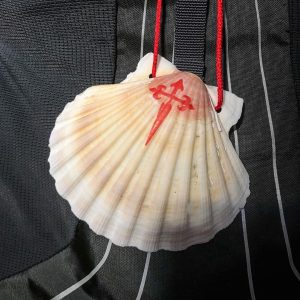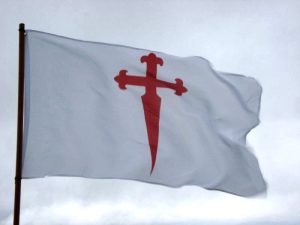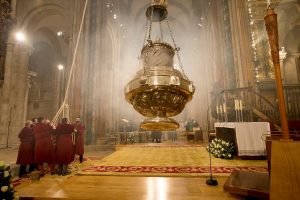
Pilgrim’s shell (scallop shell, concha de vieira)
The scallop shell has long been the symbol of the Camino de Santiago. Over the centuries the scallop shell has taken on mythical, metaphorical and practical meanings, even if its relevance may actually derive from the desire of pilgrims to take home a souvenir.
Two versions of the most common myth about the origin of the symbol concern the death of Saint James, who was martyred by beheading in Jerusalem in 44 AD.
Version 1: After James’ death, his disciples shipped his body to the Iberian Peninsula to be buried in what is now Santiago. Off the coast of Spain a heavy storm hit the ship, and the body was lost to the ocean. After some time, however, the body washed ashore undamaged, covered in scallops.
Version 2: After James’ death his body was mysteriously transported by a ship with no crew back to the Iberian Peninsula to be buried in what is now Santiago. As James’ ship approached land, a wedding was taking place on the shore. The young groom was on horseback, and on seeing the ship approaching, his horse got spooked, and the horse and rider plunged into the sea. Through miraculous intervention, the horse and rider emerged from the water alive, covered in seashells.
As the symbol of the Camino de Santiago, the shell is seen very frequently along the trails. The shell is seen on posts and signs along the Camino in order to guide pilgrims along the way. The shell is even more commonly seen on the pilgrims themselves. Wearing a shell denotes that one is a traveler on the Camino de Santiago. Most pilgrims receive a shell at the beginning of their journey and either attach it to them by sewing it onto their clothes or wearing it around their neck or by simply keeping it in their backpack.
The scallop shell also served practical purposes for pilgrims on the Camino de Santiago. The shell was the right size for gathering water to drink or for eating out of as a makeshift bowl.
The scallop shell also acts as a metaphor. The grooves in the shell, which come together at a single point, represent the various routes pilgrims traveled, eventually arriving at a single destination: the tomb of James in Santiago de Compostela.

The cross of Saint James (La cruz de Santiago)
It simulates a Latin cross and a sword with three lilies in her arms and grip. It may have originated in the time of the crusades, when knights wore small crosses with sharp bottom to nail them into the floor and perform their devotions. The sword represents the chivalrous character of St. James his way of martyrdom.

Yellow arrow (flecha amarilla)
Also a popular symbol is the famous yellow arrow which indicating the actual route that crosses the villages, open fields, forests and rivers. Elijah Valina, pastor of Cebreiro, was the first pioneer who began on his pilgrimage to sign the route with this symbol, then spread it on all the way.

Modern shell
An universally identified symbol on the pilgrim’s route. This is the latest version of the scallop shell, represents schematic yellow scallop shell on blue (colors of the European Union) displayed on information boards, buildings, mile posts to help the orientation.

Gourd (calabaza)
Its empty fruit served travelers to carry aqua in medieval times. It has been a basic equipment for every pilgrim for centuries. This is the reason why eventually become a symbol of the Camino de Santiago and an inseparable image of the pilgrims.
Botafumeiro (temple censer)
One of the best known and popular symbols of the cathedral of Santiago is the botafumeiro. According to legend, in Compostela the first temple censer was built for hygienic reasons in the eleventh century. In the Middle Ages, pilgrims, exhausted after finishing the Camino, crowded into the cathedral and, to combat the accumulation of body odors, breeding ground for epidemics, was commissioned a large censer. In the sixteenth century, thanks to a gift of King Louis XI of France, medieval artifact was replaced by a new one also made of silver. The censer was stolen by Napoleon’s troops in 1809 during the Spanish War of Independence. Therefore, the Louis XI censer was replaced by the present less ostentatious Losada thurible in 1851. After 155 years of use, the Botafumeiro was restored in early 2006.
The Botafumeiro is NOT used at every Pilgrims’ Mass in the Cathedral. It is used on Feast Days and when groups specially arrange it.






